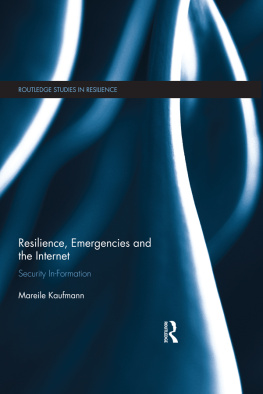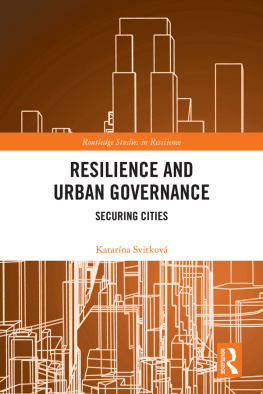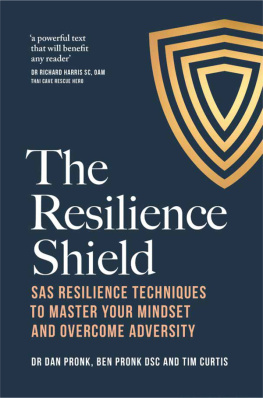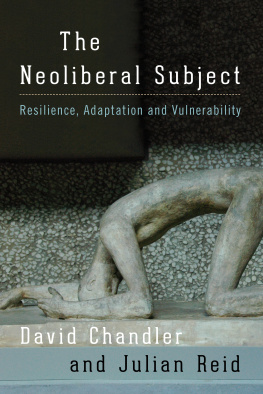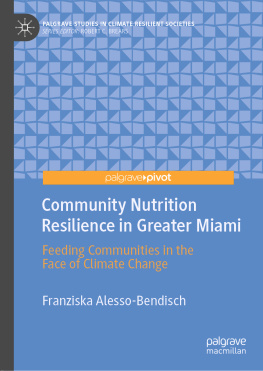
Community Resilience
This book provides an alternative perspective on community resilience, drawing on critical sociological and social policy insights about how people individually and collectively cope with different kinds of adversity.
Based on the idea that resilience is more than simply an invention of neoliberal governments, this book explores diverse expressions of resilience and considers what supports and undermines peoples resilience in different contexts. Focusing on the United Kingdom, it examines the contradictions and limitations of neoliberal resilience policies and the role of policy in shaping how vulnerabilities are distributed and how resilience is manifested.
The book explores different types of resilience including planning, response, recovery, adaptation and transformation, which are examined in relation to different types of threat such as financial hardship, disasters and climate change. It argues that resilience cannot act as an antidote to vulnerability, and aims to demonstrate the importance of shared institutions in underpinning resilience and in preventing socially created vulnerabilities. It will be of interest to academics, students and well-informed practitioners working with the concept of resilience within the subject areas of Sociology, Social Policy, Human Geography, Environmental Humanities and International Development.
Katy Wright is Lecturer in Sociology & Social Policy at the University of Leeds. She is the Programme Director of the MA in Social & Public Policy and the Deputy Director of the Bauman Institute and of the Centre for Transdisciplinary Methodology.
Routledge Advances in Sociology
323 The Paradigm of Social Interaction
Nikolai Genov
324 Identifying and Managing Risk at Work
Emerging Issues in the Context of Globalisation
Edited by Chris L. Peterson
325 The New Sociology of Ageing
Martin Slattery
326 The Class Structure of Capitalist Societies, Volume 2
Social Space and Symbolic Domination in Three Nations
Will Atkinson
327 We, Other Utopians
Recombinant DNA, Genome Editing, and Artificial Life
Eva lesingerov
328 Sociology of World Heritage
An Asian Perspective
Ogino Masahiro
329 Paramilitary Groups and the State under Globalization
Political Violence, Elites, and Security
Edited by Jasmin Hristov, Jeb Sprague and Aaron Tauss
330 The Disfigured Face in American Literature, Film, and Television
Cornelia Klecker and Gudrun M. Grabher
For more information about this series, please visit: https://www.routledge.com/Routledge-Advances-in-Sociology/book-series/SE0511
First published 2022
by Routledge
2 Park Square, Milton Park, Abingdon, Oxon OX14 4RN
and by Routledge
605 Third Avenue, New York, NY 10158
Routledge is an imprint of the Taylor & Francis Group, an informa business
2022 Katy Wright
The right of Katy Wright to be identified as the author of this work has been asserted in accordance with Sections 77 and 78 of the Copyright, Designs and Patents Act 1988.
All rights reserved. No part of this book may be reprinted or reproduced or utilised in any form or by any electronic, mechanical, or other means, now known or hereafter invented, including photocopying and recording, or in any information storage or retrieval system, without permission in writing from the publishers.
Trademark notice: Product or corporate names may be trademarks or registered trademarks, and are used only for identification and explanation without intent to infringe.
British Library Cataloguing-in-Publication Data
A catalogue record for this book is available from the British Library
Library of Congress Cataloging-in-Publication Data
Names: Wright, Katy (Katy J.), author.
Title: Community resilience : a critical approach / Katy Wright.
Description: Abingdon, Oxon ; New York, NY : Routledge, 2021. | Includes bibliographical references and index.
Identifiers: LCCN 2021033191 (print) | LCCN 2021033192 (ebook) | ISBN 9781138329478 (hardback) | ISBN 9781032139333 (paperback) | ISBN 9780429448188 (ebook)
Subjects: LCSH: Community organization. | Community development. | Urban policy. | Emergency management. | Communities.
Classification: LCC HM766 .W75 2021 (print) | LCC HM766 (ebook) | DDC 307.14dc23
LC record available at https://lccn.loc.gov/2021033191
LC ebook record available at https://lccn.loc.gov/2021033192
ISBN: 978-1-138-32947-8 (hbk)
ISBN: 978-1-032-13933-3 (pbk)
ISBN: 978-0-429-44818-8 (ebk)
DOI: 10.4324/9780429448188
Typeset in Times New Roman
by KnowledgeWorks Global Ltd.
Contents
- Resilience
- Risk
- Community, cohesion and organisations
- Preparation and planning
- Response and recovery
- Adaptation and transformation
- Community resilience in the COVID-19 pandemic
- Conclusion
- 2 Resilience
- 3 Risk
- 4 Community, cohesion and organisations
- 5 Preparation and planning
- 6 Response and recovery
- 7 Adaptation and transformation
- 8 Community resilience in the COVID-19 pandemic
- 9 Conclusion
Chapter 1 Introduction
DOI: 10.4324/9780429448188-1
The topic of resilience has been widely debated and critiqued over recent years across academic, popular and political arenas, to the point where the concept has been declared politically and intellectually exhausted ().
As has been widely noted, the emergence of resilience in policy has been closely linked with neoliberal agendas in which resilience tends to be framed in terms of self-sufficiency and self-reliance, and is tied up with agendas of abandonment and responsibilisation of citizens in a context of state withdrawal and cuts. However, a key argument of this book is that resilience can be disentangled from its neoliberal interpretations and that, as a metaphor, it can be understood in other ways which can incorporate diverse expressions of resilience, including those which emerge and operate beyond and outside of state-led strategies and interventions. Furthermore, this book suggests that there is value in exploring the contradictions inherent in neoliberal resilience policy; namely, that far from producing citizens skilled in the art of living dangerously (Evans & Reid 2013), neoliberal policies of abandonment and responsibilisation create conditions within which people find it increasingly difficult to cope. In this context, resilience is little more than an aspirational rhetorical device (: 22) suggest, demands for resilience without the collective and infrastructural powers and resources to realise resilience are disingenuous at best, toxic at worst. However, viewing resilience as more than merely a passive submission to structural disadvantage opens up space for exploring transformative, disruptive and subversive modes of resilience as well as everyday modes of coping which are often overlooked.
As such, this book is based on the idea that we do want to be resilient, in the sense of being able to cope and to avoid downward social trajectories in contexts of rapid change and in the face of diverse threats. It presents a critical account which links resilience debates with critical sociological and social policy insights into vulnerability, coping and social suffering, exploring what factors shape resilience and vulnerability at local levels and in specific contexts of adversity, and examining the role of policy and government in the production and distribution of risks. The understanding of resilience which underpins the book is that it is multifaceted and complex, and the aim is to move beyond a focus on the creation of resilient subjectivities and engage with resilience as more than something which can be reduced to a set of indicators. The aim is not to provide a recipe for resilience but to contribute to a nuanced understanding of resilience which recognises that it is comprised of different sorts of resources and is shaped at multiple levels, as well as being collectively built, culturally mediated and historically situated. A key argument I want to make is that people are individually and collectively resilient in many ways, though their resilience is often misrecognised, misinterpreted or overlooked. Furthermore, resilience tends to have costs, whether these are emotional, financial, material or temporal (: 27) it can be undermined, diminished, weakened or reduced through repeated adversity and/or through a lack of necessary support. In this sense, whilst resilience is sometimes seen as an antidote to vulnerability, this book explores the relationship between the two somewhat differently and considers how increased vulnerability, meaning situational vulnerabilities created via structural causes, undermines resilience. Although resilience strategies might involve learned or developed skills emerging from contexts of struggle, this does not mean that our capacity for resilience is infinitely elastic or necessarily transferable across different contexts of adversity or struggle. Neither does it mean that introducing new forms of vulnerability or withdrawing important sources of support will necessarily produce effective resilience strategies, or that the types of resilience which emerge from conditions of abandonment are necessarily sustainable or desirable in terms of their outcomes. As such, the book aims to demonstrate the importance of shared institutions in underpinning resilience and in preventing socially created vulnerabilities.


